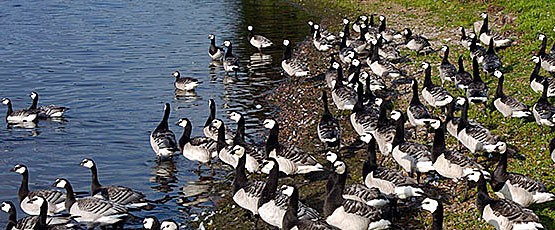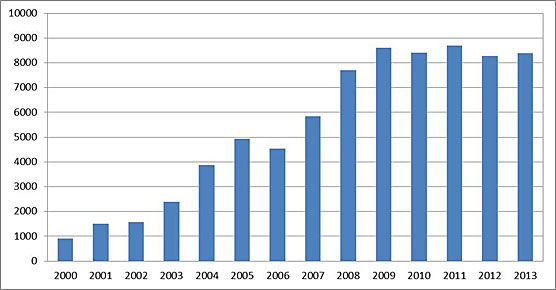Press release 2013-10-08 at 10:20
SYKE, University of Helsinki and BirdLife Finland
The barnacle goose population in Finland increased by eight per cent year-on-year. The highest growth was observed in the eastern Gulf of Finland, whereas population growth seems to have stopped in the Helsinki and Turku regions. In an autumn counting of barnacle geese organised by the Finnish Environment Institute (SYKE), the University of Helsinki and BirdLife Finland, a total of 21,700 geese were counted.

Barnacle geese congregated in the Otsolahti bay in Espoo. Photo by Riku Lumiaro.
Birdwatchers performed a counting of barnacle geese throughout Finland during the weekend 31 August–1 September 2013. According to the results, the autumn population of barnacle goose increased by eight per cent year-on-year. The highest growth was observed in the eastern Gulf of Finland, where the autumn population tripled. The population also increased in the Gulf of Bothnia and inland areas, whereas the population remained unchanged in South-Western Finland and the Helsinki region.
As in previous years, the highest number of barnacle geese was recorded in the metropolitan area: a total of 8,400 birds. The largest populations in the metropolitan area were found in Helsinki in Viikki (4,700 birds), in Vantaa in Hämeenkylä (1,600) and in Espoo in Laajalahti (1,500).
High numbers of barnacle geese were also concentrated in the Turku (3,200 birds), Mynämäki (2,800), Pori (2,800), Kotka-Hamina (1,900) and Kristiinankaupunki (900) regions. In addition, flocks of several hundreds of barnacle geese were observed in Kokkola, Vaasa, Virolahti and Vöyri. Inland, the highest number of barnacle geese was recorded in the Hollola-Lahti region (580 birds).
Population grows outside large urban areas
In the period 2009–2013, the autumn population in the metropolitan area has ranged from 8,300 to 8,700 barnacle geese. The size of the breeding population has also become stable in the Helsinki, Espoo and Sipoo region, where some 1,300 pairs of barnacle geese have been nesting annually during the past three years. This seems to indicate that population growth in the metropolitan area has stopped. The quality of nesting and brooding areas is already restricting the size of the population.
The increase in population size also seems to have levelled off in the Turku region, whereas the breeding population continues to grow outside large urban areas both in the coastal archipelago and on inland lakes. For example in the Gulf of Finland National Park, the breeding population increased considerably compared to 2012, and the species is spreading into the inner archipelago. More than 100 pairs of barnacle geese nested in the Lake Vesijärvi area in Lahti for the first time this summer.
Further information:
Markku Mikkola-Roos, Senior Researcher, Finnish Environment Institute (SYKE), tel. +358 400 148 685
firstname.lastname@ymparisto.fi
Veli-Matti Väänänen, University Lecturer, University of Helsinki, tel. +358 400 771 232
firstname.lastname@helsinki.fi
Tero Toivanen, Conservation Officer, BirdLife Finland, tel. +358 40 702 8633
firstname.lastname@birdlife.fi
The autumn population of barnacle goose in the metropolitan area in 2000–2013.
